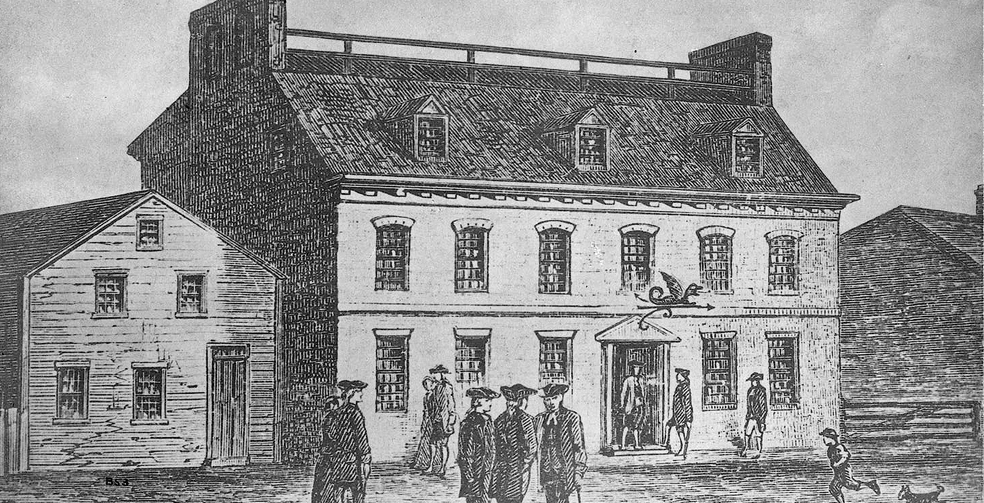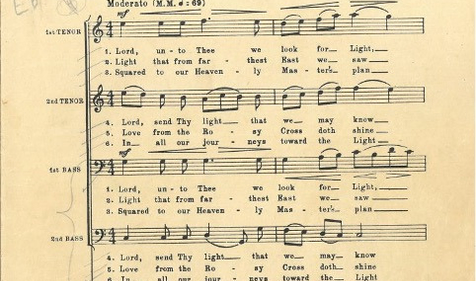An exploration of the legacy of Boston’s Green Dragon Tavern and their famous sculptural green dragon sign.
This blog was originally published on the Scottish Rite Masonic Museum & Library’s blog on April 5, 2022.

As we look forward to Patriots’ Day here at the Scottish Rite Masonic Museum & Library, our minds turn to objects in our collection related to the American Revolution. Among these is the dramatic sculpture pictured here. This sculpture is a reproduction of a tavern sign that once hung over Boston’s fabled (and no longer surviving) Green Dragon Tavern and connects viewers to the remembrance of important events relating to our nation’s origins.
This sculptural dragon’s story is as winding as its tail. The original Green Dragon Tavern, in operation as early as 1712 and located on Union Street in Boston’s North End, attracted customers with a metal (possibly copper) sign in the shape of a dragon over its door. The Lodge of St. Andrew met at the tavern and purchased the building in 1764. The tavern continued to operate in the basement while the Lodge used the upper floors for its meetings. This structure burned down in 1832, and the original dragon sign was lost.
The Lodge rebuilt the building after the fire. For its centennial in 1856, a new sign in the shape of a dragon was commissioned. It was modeled after its predecessor as closely as could be determined but was made of sandstone instead of metal. This 1855 dragon sign was also lost sometime after it was created.
The sign shown here, sculpted in bronze, has more mysterious origins. It was discovered in 1947 by clothing store proprietor Samuel Lebow, who had purchased the Lodge of St. Andrew’s building to use as his shop. Lebow, himself a Freemason, gave the dragon to the Grand Lodge of Masons in Massachusetts the same year he found it.
The original Green Dragon Tavern—referred to as the “Headquarters of the Revolution” by Daniel Webster and a “nest of sedition” by Royal Governor Thomas Hutchinson—was the location at which the Sons of Liberty met to plan out the Boston Tea Party. An 1898 artist’s rendering of that storied night, with the tavern and its sign in the shape of a dragon in the background, can be seen below. Lodge of St. Andrew members Paul Revere (1734-1818), John Hancock (1736/7-1793), and Joseph Warren (1741-1775) were also members of the Sons of Liberty and deeply involved in the group’s activities.

Today, this dragon sign, part of the collection of the Grand Lodge of Masons in Massachusetts, is cared for by the Scottish Rite Masonic Museum & Library. If you would like to see it in person, it is currently on view in our exhibition, “The Masonic Hall of Fame: Extraordinary Freemasons in American History.”
References:
Newell, Aimee E., et al. Curiosities of the Craft: Treasures from the Grand Lodge of Massachusetts Collection. Boston: Grand Lodge of Masons in Massachusetts and Lexington, Massachusetts: Scottish Rite Masonic Museum & Library, 2013, pp. 54-55.
Gimber, Karl and Mary Jo. “Hook a Tavern Sign.” Early American Life, Feb. 2012, pp. 72-73.
The Lodge of Saint Andrew, and the Massachusetts Grand Lodge. Boston: Lodge of St. Andrew, 1870, pp. 184-185.
Related Stories
Discover additional Scottish Rite blogs and news on this topic.



